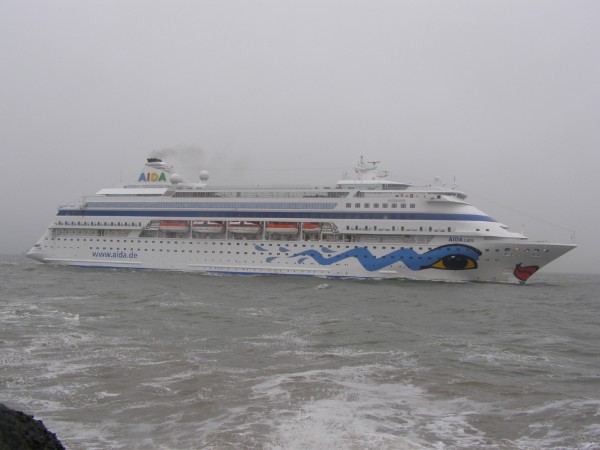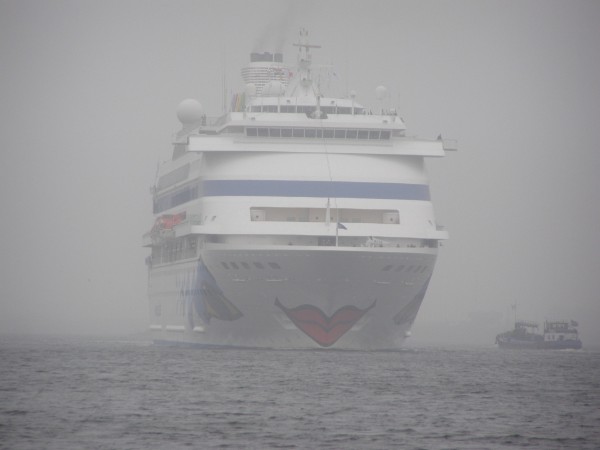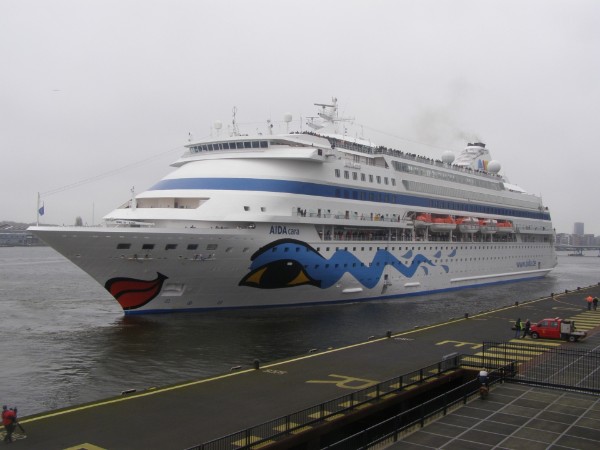AIDAcara

AIDAcara as seen between the pierheads at IJmuiden, The Netherlands at the 6th of april 2011.
Background
After the fall of the communist block in eastern Europe, the former state-owned companies had to be re-organised as private firms. The Deutsche Seereederei was one of those as the former shippingcompany from the German Democratic Republic and it was privatized at the 3rd of june of 1993. The company was bought by two investors from Hamburg, Horst Rahe and Nikolaus H. Schües at the moment when the passengerfleet was two ships, the 1980-built Arkona and the 1974-built Astra II. The two new investors came up with a plan to reform the passengerdivision into a very informal holiday-style company. They fine-tuned their ideas and at the 26th of august of 1994, they ordered their first newbuilding from the Finnish Kvearner-Masa Yards, located in the town of Turku, the first German company ordering a ship from this well-known yard.
Construction and general statistics
The keel of the new ship was laid at the 11th of september in 1995 and she was built under yardnumber 1337. She was going to be 193,34 meters long with a width of 27,60 meters and a draught of 6,20 meters. Her tonnage measurement was 38.531 and her maximum passengercapacity was 1250 persons, but on a two-per-cabin basis the number given is 1186. Those passengers have the companionship of around 370 crewmembers. Because of the informal clubship style, the passenger to crew-ratio aboard was significantly lower then the ratio aboard other cruiseliners, as you can see within those numbers. The ship was driven by two propellers, powered by four six-cylinder diesel engines designed by MAN B&W. It gives the ship a normal service speed of around 21 knots. The ship has eleven decks, but only nine of those are used by the passengers. Her homeport was Rostock, so she flew the flag of Germany as all ships of the company had done before. Note here is of course that normally, the ships had flown the flag of the German Democratic Republic, but due to the unity of both Germanies now the flag of the united country was flying. The outer design of the ship was based on the 1991-built Sally Albatross, that later sailed under the names Leeward for Norwegian Cruise Line, Superstar Taurus for Star Cruises, Silja Opera for Silja Line and for Louis Cruise Lines as Louis Crystal. The ship is now in service for Celestyal Cruises as their Celestyal Crystal. This ship had also been built in Finland, not on the same yard though, she came from the Finnyards at Rauma.
The new ship for Deutsche Seereederei was designed and built within a record time of just 22 months and she was launched at the 16th of february of 1996. She was delivered to the company at the following 4th of june and a few days later, at the 7th of june, she was named Aida in the port of Warnemünde in northern Germany. Her godmother was Christiane Herzog, the wife of Roman Herzog who was the first President of the re-united German Republic. The name Aida was chosen, as the other ships within the company had also names starting and ending with the letter 'A'. Aida didn't have true sisterships, although the later AIDAvita (2002) and AIDAaura (2003) were enlarged versions of similar design.
From a dence fog at the Northsea Canal close to IJmuiden, AIDAcara seems friendly and happy and eager to follow her way to Amsterdam.

Design
The most striking recognizable feature was of course her distinctive hull-art. Nowadays it is normal for every cruiseline to add hullart to their ships, but Aida was in fact one of the first ships to have such a thing. The design was from Feliks Büttner and his inspiration came from Egyptian hieroglyphics. In his design, he wanted to capture some of the mysteries of ancient Egypt and this was not randomly chosen. Aida was of course an opera written by Giuseppe Verdi in 1871 and it was about a young Egyptian princess in ancient times, so the hullart was fitting for a ship with this name. The interiours of the ship were designed by Kai Bunge of the company Partner Ship Design from Hamburg, a company that has been involved in every cruiseship within the later fleet also. Within the new concept as a clubship, the ship had two very large market-style buffet restaurants aboard and this also explains the lesser amount of crewmembers, as there are less waiters. Next to those reataurants, there was also an a-la-carte restaurant though, named the Maritime Restaurant. The cabins are only cleaned once a day instead of two or three times, also saving housekeeping staff and there is not the possibility of dining in the cabins. The main showlounge named Das Theater is spread over two decks and seats 540 passengers. Two playrooms for children are also there, next to an innovative bar area where the actual bar was built in the middle in the form of a compass rose. In this configuration, it is very easy to get in touch with other passengers and there is much more room to sit at the bar too. This concept has been placed aboard every following ship within the fleet also and is a passengers favorite. A large space of deck 9 is reserved for the fitness and beauty areas and those are decorated with palmtrees, real-looking rock and cave formations and a waterfall. Also at this deck is the large wintergarden, that can be reached via a raised bridge. The ship also has a large amount of open deckspace with sportfacilities, a pool and whirlpools, next to a poolside bar.
In contradiction to the other older ships within the fleet, Aida was a very modern ship with light and bright colours. The public rooms are located at decks 8 to 11 and the cabins are located between deck 4 and deck 7. With this, the company did not follow the more modern approach since Princess Cruises Royal Princess of 1984, where the public rooms are mostly located lower in the hull so the cabins can have balconies at the higher decks.
Early carreer and owner-changes
Aida sailed her first cruise departing Bremerhaven for Palma de Mallorca at the 11th of june of 1996. In her first summerseason she was homeported in the Mallorcan port and this port also became the main hub for the company in the Mediterranean afterwards. At the end of the summer, the ship sailed for the Caribbean for her first winterseason, before returning to the Mediterranean in the summer of 1997. In august 1997, the ship was sold to Norwegian Cruise Line and chartered back to Deutsche Seereederei Touristik. Not much changed, only her homeport became Monrovia, so she now flew the Liberian flag. Exactly two years later, the ship was bought back by her former owners, only they themselves had reformed as Arkona Touristik. Aida was from now on manageged under the banner of Aida Cruises. This was a joined venture between Arkona Touristik, who held 49 % of the stocks in Aida Cruises, and the P&O Group, who owned the other 51% of the stocks. So Aida Cruises was now more or less controlled via the P&O Group. Under this new ownership, two new ships were added to the fleet of Aida Cruises, the AIDAvita and the AIDAaura. These ships were designed as larger versions of Aida, with even the same hull-art. This characteristic mouth, eyes and eyeshadow that gives the ships such a friendly look. With just over 42.000 tons, these new ships were somewhat larger. When they came into service, Aida was renamed AIDAcara. She recieved her new name in november 2001. Between the 5th of april 2002 and the 1st of november 2004, Seetours was named as the owner of the ship, and she was registered in London. This, of course, is a traditional P&O homeport and the Seetours name was also owned by P&O. After the merger from P&O with the Carnival Corporation, AIDA Cruises was listed as the owner of the ship, and she again got a new home, this time she was reflagged to Italy and her homeport now was Genoa. This was done because Carnival placed AIDA Cruises under the management of Costa Cruises, separating it from P&O.
AIDAcara entering the port of Amsterdam at the 6th of april 2011, reflected in the windows of the 'Muziekgebouw aan het IJ.' This building has become a landmark at the Amsterdam port from 2002 onwards, housing two main musicvenues, a large café and a promenade along the cruiseterminal, that is its neighbour.

Later carreer under the name of AIDA Cruises
At the 18th of april 2005, AIDAcara was sent to the Neptun Stahlbau Industrie wharf at Rostock, her original homeport, where 44 cabins recieved balconies. Because of this, also the bridgewings had to be extended by 1,8 meters so there still was a good view backwards, not obstructed by the new balconies. Next to this, the ship was also slightly rebuilt inside, so the passengercapacity was enlarged to 1298. The ship was not longer only sailing the Mediterranean and the Caribbean, she also undertook cruises in western and northern Europe, South America and even up the Amazon river in Brazil. For the Amazon cruises, AIDAcara is one of the largest cruiseships able to sail here. In 2006, AIDAcara was the first cruiseship that regularly sailed around the Arabian peninsula. In the spring of 2010, she undertook her first worldcruise from Bangkok, Thailand, to Hamburg, Germany.
In october of 2013, the ship was overhauled at the Lloyd Werft at Bremerhaven, where a new youthlounge and a gallery were installed. Also, the ship was the first cruiseship in the world to recieve a filter to reduce the emissions of diesel particulates, as well as sulphuroxide scrubbers, which are exhaust gas cleaning systems. This system was developed by Carnival Corporation, together with the US Environmental Protection Agency and the US Coast Guard, and is the first of its kind to be installed aboard a ship, although it had been installed in powerplant and automotive sectors on land already. With the system, Carnival is showing that the cruise-industry is trying to built as environmentfriendly as possible, something that is becoming more important within shipdesign in the future.
AIDAcara ready for docking at the Passenger Terminal Amsterdam.


